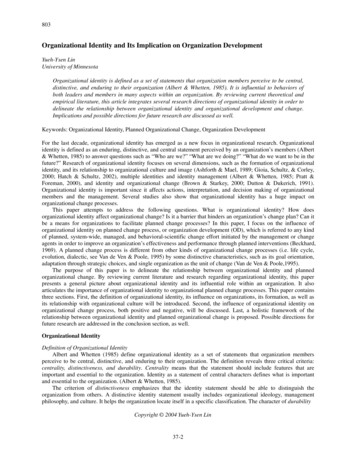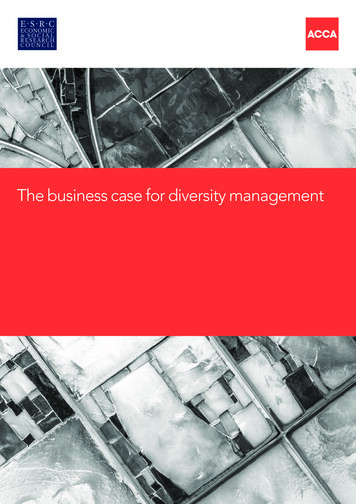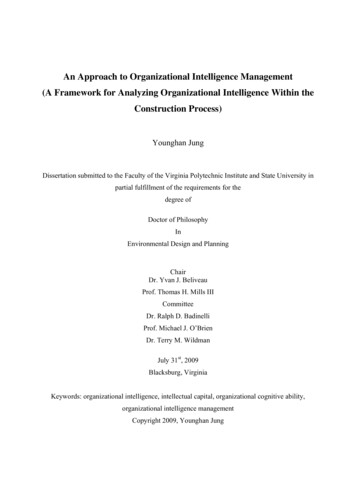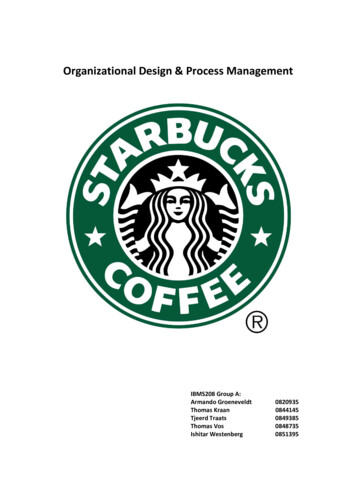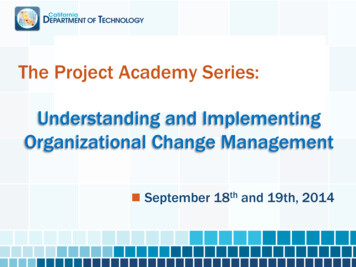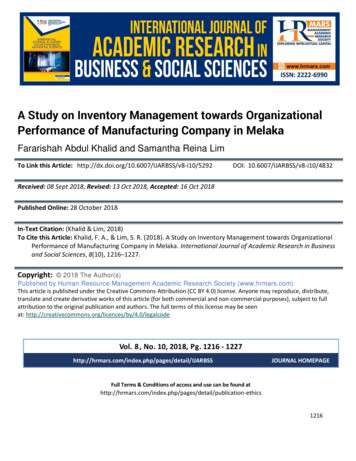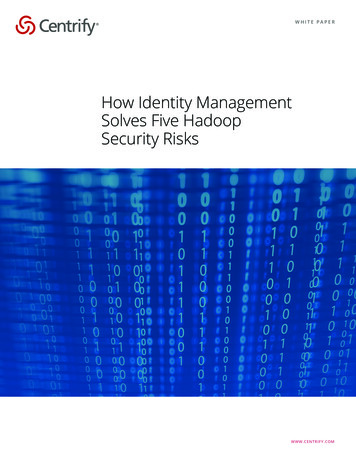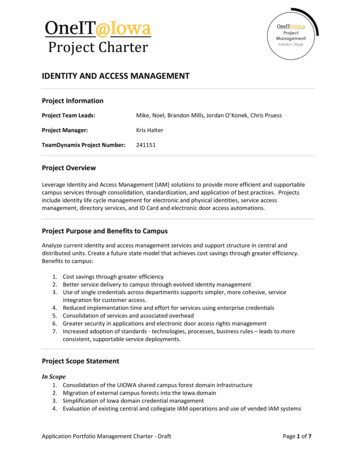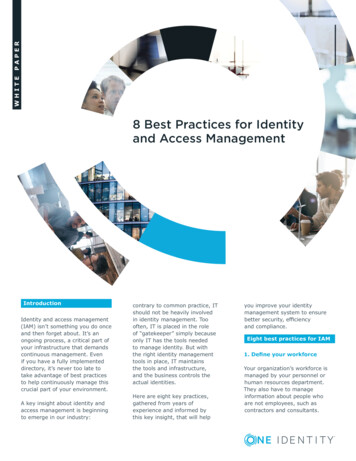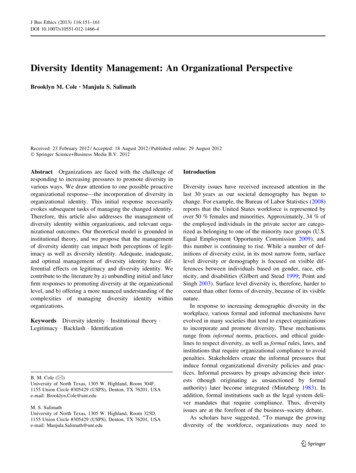
Transcription
J Bus Ethics (2013) 116:151–161DOI 10.1007/s10551-012-1466-4Diversity Identity Management: An Organizational PerspectiveBrooklyn M. Cole Manjula S. SalimathReceived: 23 February 2012 / Accepted: 18 August 2012 / Published online: 29 August 2012 Springer Science Business Media B.V. 2012Abstract Organizations are faced with the challenge ofresponding to increasing pressures to promote diversity invarious ways. We draw attention to one possible proactiveorganizational response—the incorporation of diversity inorganizational identity. This initial response necessarilyevokes subsequent tasks of managing the changed identity.Therefore, this article also addresses the management ofdiversity identity within organizations, and relevant organizational outcomes. Our theoretical model is grounded ininstitutional theory, and we propose that the managementof diversity identity can impact both perceptions of legitimacy as well as diversity identity. Adequate, inadequate,and optimal management of diversity identity have differential effects on legitimacy and diversity identity. Wecontribute to the literature by a) unbundling initial and laterfirm responses to promoting diversity at the organizationallevel, and b) offering a more nuanced understanding of thecomplexities of managing diversity identity withinorganizations.Keywords Diversity identity Institutional theory Legitimacy Backlash IdentificationB. M. Cole (&)University of North Texas, 1305 W. Highland, Room 304F,1155 Union Circle #305429 (USPS), Denton, TX 76201, USAe-mail: Brooklyn.Cole@unt.eduM. S. SalimathUniversity of North Texas, 1305 W. Highland, Room 325D,1155 Union Circle #305429 (USPS), Denton, TX 76201, USAe-mail: Manjula.Salimath@unt.eduIntroductionDiversity issues have received increased attention in thelast 30 years as our societal demography has begun tochange. For example, the Bureau of Labor Statistics (2008)reports that the United States workforce is represented byover 50 % females and minorities. Approximately, 34 % ofthe employed individuals in the private sector are categorized as belonging to one of the minority race groups (U.S.Equal Employment Opportunity Commission 2009), andthis number is continuing to rise. While a number of definitions of diversity exist, in its most narrow form, surfacelevel diversity or demography is focused on visible differences between individuals based on gender, race, ethnicity, and disabilities (Gilbert and Stead 1999; Point andSingh 2003). Surface level diversity is, therefore, harder toconceal than other forms of diversity, because of its visiblenature.In response to increasing demographic diversity in theworkplace, various formal and informal mechanisms haveevolved in many societies that tend to expect organizationsto incorporate and promote diversity. These mechanismsrange from informal norms, practices, and ethical guidelines to respect diversity, as well as formal rules, laws, andinstitutions that require organizational compliance to avoidpenalties. Stakeholders create the informal pressures thatinduce formal organizational diversity policies and practices. Informal pressures by groups advancing their interests (though originating as unsanctioned by formalauthority) later become integrated (Mintzberg 1983). Inaddition, formal institutions such as the legal system deliver mandates that require compliance. Thus, diversityissues are at the forefront of the business–society debate.As scholars have suggested, ‘‘To manage the growingdiversity of the workforce, organizations may need to123
152implement systems and practices so that the potentialadvantages of diversity are maximized and the potentialdisadvantages are minimized’’ (Cox 1994; McMillanCapehart et al. 2009). Hence, diversity managementbecomes an important organizational task that requires anorganizational perspective for its full understanding.No doubt, expectations (to incorporate diversity) areethically, socially, politically, and economically pertinentto the well-being of organizations. Yet, firm responses tosuch diversity-related demands can vary. For example,organizations can choose to be reactive or proactive in theirresponse to diversity issues. Among the many proactiveresponses, organizations may decide to actively includediversity as a component of their identity. Such inclusion ispossible because organizational identity is malleable tosocietal ‘‘issues’’ and expectations (Dutton and Dukerich1991). ‘‘An organization’s identity reflects its central anddistinguishing attributes, including its core values, organizational culture, modes of performance, and products’’(Elsbach and Kramer 1996: 442). Hence, incorporatingdiversity in an organization’s identity reflects the adoptionof a favorable societal value.However, including societal values may not alwaystranslate to economic benefits for the organization. Interestingly, prior diversity research is inconsistent as to thebenefits and drawbacks of diversity identity incorporation,contending it is a ‘‘double-edged sword’’ (Trefry 2006).Conflicting results were reported about diversity’s directinfluence on positive organizational outcomes (Gilbert andStead 1999; Gonzalez and DeNisi 2009; Hamdani andBuckley 2011). In particular, those organizations focusingsolely on economic gain derived from diversity have beendisappointed with negative results (Pless and Maak 2004).Consequently, researchers have explored alternate outcomes that organizations may experience from incorporating diversity, such as increased legitimacy (Martin,Johnson, and French 2011; Hamdani and Buckley 2011;Harris and Wicks 2010).While some criticize this inclusion (alluding that theincorporation of diversity in the organization’s identity ismerely a ‘‘window dressing’’ conveyed to satisfy societalpressures), evidence of increased external legitimacy perceptions have been found, indicating that the organizationis indeed receiving a benefit (Bartkus and Glassman 2008).This supports the firm’s proactive rather than reactiveefforts to promote diversity identity to external stakeholders. Still, this does not necessarily predict either the internaladoption of practice, or the outcome of perceived legitimacy (Dobbin et al. 2011). Organizations that promote adiverse identity but fall short in its actual practice will loseperceived legitimacy; therefore, it is necessary to activelymanage diversity identity. Further, we believe that inconsistent results from prior research may likely be due to123B. M. Cole, M. S. Salimathvariations in the extent to which diversity identity iseffectively managed within organizations.The internal practice, or management, of diversity identity varies between organizations. We define diversityidentity management as including but not limited to thevoluntary communication of diversity beliefs to stakeholders as well as the implementation of internal diversity programs and policies. We argue that the management ofdiversity identity is broader than that of diversity management alone, which is focused predominately on the internalactions and policies of the organization (Ivancevich andGilbert 2000). Hence, management of diversity identityincludes the organization’s promotion of diversity as a corevalue to society through strategically designed statements(Point and Singh 2003). Richard et al. (2007) found thatorganizations benefit from the promotion and strong (ratherthan weak) management of diversity. While this makes senseintuitively, it must be noted that identity is a dynamic andmultiplex construct and consists of various other elements(e.g., other identities such as professional identity, roleidentity, etc.). It is likely that as the promotion of diversityidentity increases, it is at a cost to various other identities thatemployees may associate with. While the perceptions of anorganization’s diversity identity by the minority group/women as well as white males have been evaluated (Mollica2003; Dobbin et al. 2011; Thomas and Wise 1999), it issurprising that perceptions of the rest or full spectrum ofemployees has not yet been assessed. In addition, themajority of prior research has focused on individual leveloutcomes, ignoring organizational consequences. Thus, wetake an organizational perspective to address diversityidentity management. To the best of our knowledge, there isno discussion either on the balance between promotion/reduction of one identity aspect such as diversity versusanother identity aspect such as professional identity, onrelevant organizational outcomes such as legitimacy.The primary purpose of this article, therefore, is tocontribute to the literature by unbundling initial and laterfirm responses to promoting diversity at the organizationallevel (see Fig. 1). We consider organizational responses tostakeholder pressures to incorporate diversity as well as theconsequences of such action at the organizational level.Initial proactive responses may include the creation of adiversity identity. This response is sufficient to ensurelegitimacy and diversity identity to external stakeholders.Later responses may include efforts to actively manage thediversity identity to minimize threats to legitimacy. Thislater response is necessary to ensure legitimacy and diversity identity internally to employees and organizationalmembers. We examine differential effects of diversityidentity management and their impact on organizationaloutcomes such as legitimacy. We contend that althoughunnecessary in the external environment, the active
Diversity Identity Management153management of diversity identity is critical internally forminimizing threats to legitimacy. Throughout, we groundour explanations in institutional theory.The rest of this article is organized as follows. We beginby discussing the societal pressures for diversity adoptionand the influence on organizational outcomes of legitimacyand identity. Next, we discuss the incorporation of diversity in the organization’s identity, and the management ofdiversity identity. The theoretical model, illustrative figures, and propositions are provided as well as implicationsand future directions for research (Fig. 2).PropositionsStakeholder Pressures to Promote Diversityin Organizations and Institutional TheoryInstitutional theory (Selznick 1949; Meyer and Rowan1977; DiMaggio and Powell 1983) examines the way inwhich structures are formed by society and becomeingrained. Examples of structures include rules, norms, andother established criteria for social behavior. Institutionalization is important as it can impact an individual’s perception of legitimacy of an organization. By utilizingvisible symbolic cues, such as diversity management programs or diversity statements, organizations constructperceptions of legitimacy among key stakeholders. Suchcues are additionally signaled by—compliance with legalrequirements, accreditations, professional associationmembership, and media (MacLean and Behnam 2010). Totrace the formal incorporation of diversity in the organization’s identity, we can look at the informal drivers thathave led to the evolution of diversity statements andmanagement as a result of coercive, normative, andmimetic isomorphic pressures (DiMaggio and Powell1983, 1991; McKinley et al. 1995) on the organization.Coercive pressures occur when there is a threat of adverseconsequences if the organization does not adopt standardpractices or obey laws and regulations. The 1960s marked thebeginning of employment reform with the Civil RightsMovement. During this period, strong action was taken bygovernment to legally address injustice against the AfricanAmerican race. The initial push originated in 1961, by President Kennedy when he first introduced the term affirmativeInitial ResponseIncorporation of Diversity in IdentityExternal Legitimacy and Diversity IdentityLater ResponseManagement of Diversity in IdentityInternal Legitimacy and Diversity IdentityFig. 1 Unbundling proactive firm responses to promote diversityP2P3 a, b, cP1Fig. 2 Theoretical model of proactive firm responses to diversityissuesaction. Affirmative action (AA) was imposed upon federalcontractors initially to ensure that ‘‘race, creed, color, ornational origin’’ would not bias employment (Kelly andDobbin 1998). This major legal action was followed by the1964 Civil Rights Act in which Title XII made employmentdiscrimination illegal (Kelly and Dobbin 1998). In 1965,President Johnson’s modification of Kennedy’s original AAOrder, included the addition of sex as well as mandated publicand government organizations to include a prewritten statement constructed to promote equality and fair hiring practices(Wilkins 2004). Although the legal mandate became a legitimizing factor for organizations, the enforcement and measurement remained ambiguous (Kelly and Dobbin 1998). Tocombat the increased lawsuits that arose from noncompliance,organizations began the practice of hiring equal employmentopportunity (EEO) and AA specialists (Wilkins 2004; Kellyand Dobbin 1998).Normative pressures are predominately unspoken andinclude assumptions about standard operating procedures.Normative pressures are communicated through peers andemployees of an organization. The initial shift to diversitymanagement within organizations occurred in the early1980s. The shift has largely been associated with theelection of President Reagan who campaigned on the initiative of reducing the ‘‘bureaucratic control’’ found in suchFederal implemented policies as EEO and AA (Kelly andDobbin 1998). With cuts to these programs there emerged aresistance by human resources, EEO, and AA specialists.With a desire to maintain their role in the organization,they began to reframe the existing reason for its inclusion.Selznick (1949) discussed how certain institutionalizedprocesses, instead of being deinstitutionalized, becomerepurposed and a new purpose for the existing formalprocedure is developed (Kelly and Dobbin 1998). Whenthe decline in governmental acceptance of the legallymandated EEO and AA positions emerged, a reframedpurpose for it was developed through societal pressures andorganization interdependence (Yang and Konrad 2011).The implementation of diversity practices allowed for moreobjective recruitment, hiring, and promotion (Kelly andDobbin 1998). With the change in meaning also came achange in wording. No longer was diversity management alegal policy but a beneficial program, and having a diversity statement became a norm.123
154Mimetic effects are caused when isomorphic pressurespromote similar formal structures among organizationswithin the same field (DiMaggio and Powell 1991;McKinley et al. 1995). Mimetic processes occur when anorganization copies, or mimics, aspects of other similarorganizations. Organizations tend to mimic others’ diversity management practices especially when they promotelegitimacy perceptions. The acquisition of legitimacy (evenvia mimicry) is important as it helps to enhance the survival rates of organizations (DiMaggio and Powell 1991).When an anticipated component is absent—in this case theincorporation of diversity in identity—the organizationruns the risk of losing legitimacy by not incorporating whathas been informally demanded by stakeholders and integrated by others as formal practice.By demonstrating conformity with societal issues,through the formal incorporation of diversity policies,(Nemetz and Christensen 1996), organizations gain legitimacy (Yang and Konrad 2011). As new entrants join thepopulation or competition heightens in an industry, institutional theory predicts that an organization’s pursuit oflegitimacy increases isomorphic pressure on the organization and leads to homogeneity among organizations in anindustry. This pursuit of legitimacy causes organizations toadopt socially desired practices that interest groups consider important and other organizations currently support.The implementation of practices and standards of legitimate organizations are both economic and noneconomic innature (Harris and Wicks 2010). The pressure to adoptdiversity is informally pushed even though it may have nobearing on the organization’s bottom line (Hamdani andBuckley 2011). Coercive, normative, and mimetic institutional pressures to incorporate diversity impact organizations. Those that reflect stakeholder expectations are likelyto be perceived by stakeholders to have external legitimacyand diversity identity, while those that do not reflectstakeholder expectations tend to experience external threatsto legitimacy and diversity identity. Therefore:Proposition 1 Stakeholder expectations of diversity create institutional pressures that affect external legitimacyand diversity identity of organizations.Incorporation of Diversity in IdentityOrganizations have a range of responses that they maychoose from to face the issues of diversity inclusiveness.Incorporation of diversity in an organization’s identityrequires significant commitment and effort on the part ofthe organization, as it reflects a greater commitment thansurface level or image based diversity initiatives. Forexample, on the low end of diversity incorporation, anorganization will rely on affirmative action or equal123B. M. Cole, M. S. Salimathemployment opportunity statements. These are considered‘‘remedial’’ (Kidder et al. 2004), as they are governmentmandated and have become considered an expected practice. As the organization’s goal shifts from compliance toawareness and acceptance, they should engage in diversitytraining programs and events (Valentine and Page 2006).Finally, organizations that truly drive home diversity initiatives, beyond that of compliance or awareness, willbegin to incorporate diversity as a key component instrategy and mission formulation. This high level form ofdiversity inclusion cascades from the top down and isrecognized as a substantial driver for organizationalsuccess.Many organizations are arranged by bureaucraticmethods (DiMaggio and Powell 1991); however, as discussed earlier, pressures from both internal and externalstakeholders informally influence identity formation(Martin et al. 2011; Nemetz and Christensen 1996). Identity is the internal assembly of cues that reflect whatmembers believe to be central to the organization (Christensen and Askegaard 2001; Gatewood et al. 1993; Nguyenand LeBlanc 1998). ‘‘Identity means the sum of all theways a company chooses to identify itself to all its publics—the community, customers, employees, the press,present and potential stockholders, security analysts, andinvestment bankers’’ (Margulies 1977: 66).Organizations strive for continuous identity, meaningthat the overall identity is fluid in its interpretations as eachindividual puts more weight on different issues thus producing various views (Gioia et al. 2000; Holzinger andDhalla 2007). With the development of a more reflexiveand interactive identity comes the notion of multipleidentities (Gioia et al. 2000) in which organizations try toportray different identities to relate to stakeholders. Thecommunication of certain identities will resonate morewith one particular group of individuals than others(Nguyen and LeBlanc 1998; Riordan et al. 1997).The benefit from an identity that resonates with thevalues of its key stakeholders (Dutton and Dukerich 1991),with regards to diversity, has been explored. For example,Thomas and Wise (1999) found that diversity policies weresignificant to people seeking employment. Likewise, Williams and Bauer (1994) show that the firm’s adoption of adiversity management program and having a formal statement/stance will aid in enhancing perceptions of theorganization.As organizational identity is malleable to societal issuessuch as diversity, firms may choose to respond to institutional pressures created by stakeholders by proactivelyincorporating diversity in their identity. Extant research(discussed above) has been established that organizationalidentity is not monolithic, but is multiplex and d
management of diversity identity is critical internally for minimizing threats to legitimacy. Throughout, we ground our explanations in institutional theory.

